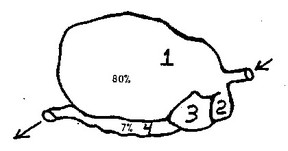Basic Goat Facts
Goat Terms |
|
|---|---|
| Male | Buck |
| Doe | Female |
| Kid | Baby Goat |
| Wether | Castrated Male goat |
| Chevon | Meat cuts |
| Cud | Bolus of food that is chewed on, |
| soaked with saliva | |
| and swallowed |
Physiological Data |
|
|---|---|
| Temperature | 101.7-104.5 |
| Heart rate | 70-80 beats per minute |
| Respiratory rate | 12-15 breaths per minute |
| Ruminal Movements | 1-1.5 per minute |
Reproductive System Female |
|
|---|---|
| Age of puberty | 7-10 months |
| Estrous cycle | |
| --Length | 18-22 days |
| --Duration | 12-36 hours |
| --Signs | Tail wagging, mounting, |
| bleating 12-36 hours from onset of | |
| Ovulation | standing heat |
| Gestation length | 146-155 days |
| Breeding Season | August-January |
| Seasonal Anestrous | February-July |
| Buck effect on estrous | Positive |
A Sick Goat |
|
|---|---|
| Diarrhea | Heavy mucous in nose and |
| Runny nose | mouth |
| No sign of chewing cud | Limping |
| Standing apart from | Hair falling out |
| the group | Off feed and Water |
| Abnormal temperature | Rough hair coat |
| Swelling on any part of body |
Pale mucous membranes of eyes and mouth |
Reproductive System Male |
|
|---|---|
| Age of puberty | 4-8 months |
| Breeding age | 8-10 months |
| Breeding Season | All year |
| Breeding ratio | 1 buck per 20-30 does |
A Healthy Goat |
|
|---|---|
| Eats well | Has strong legs and feet |
| Chews its cud | Is sociable |
| Has a shiny coat | Has bright clear eyes |
The Digestive System
The goat is a member of a class of animals called RUMINANTS. These animals chew their cud. The goat’s stomach has FOUR chambers-
1.Rumen—a big fermentation vat
2.Reticulum—honey comb structure, the “hardware stomach”
3.Omasum—removes water from the fermenting particles and also absorbs more nutrients called volatile fatty acids that helps supply the goat with energy.
4.Abomasum—true stomach, particles are digested by stomach acid

More Detailed Information on the Ruminant Digestive System
The ruminant stomach
Goats are ruminants, animals with a four-compartment stomach, as are cattle, sheep, and deer. The compartments are the reticulum, rumen, omasum, and abomasum (true stomach). Monogastric or simple-stomached animals such as humans, dogs, and cats consume food that undergoes acidic breakdown in the stomach and enzymatic digestion in the small intestine where most nutrients are absorbed. In ruminants, feed first undergoes microbial digestion in the reticulum and rumen (together often called the reticulo-rumen) prior to acidic digestion in the abomasum and enzymatic digestion and nutrient absorption in the small intestine. It is the microbial digestion in the reticulo-rumen that allows ruminants to consume and utilize grass, hay, leaves, browse, etc.
The reticulum and rumen form a large fermentation vat that contains microorganisms, mainly bacteria, that breakdown and digest feedstuffs, including the fibrous component of grass, forbs, and browse that cannot be digested by monogastric animals. Some of the breakdown products produced through digestion of feed by bacteria are absorbed by the animal through the rumen wall and can supply a large part of the energy needs. The rest of the byproducts of digestion, undigested feed, and ruminal microorganisms flow out of the reticulo-rumen into the omasum where large feed particles are trapped for further digestion and water is reabsorbed. Material then flows into the abomasum where acidic digestion takes place and then to the small intestine for further enzymatic digestion and nutrient absorption.
The rumen provides several advantages to the goat in addition to digestion of dietary fiber. The bacteria in the rumen are capable of synthesizing all B vitamins needed. Bacteria can also synthesize protein from nitrogen recycled in the body, which may be advantageous on low protein diets. For proper ruminal function, goats require a certain level of fiber (measured as crude fiber, acid detergent fiber, or neutral detergent fiber) in the diet. Goats have bacteria in the rumen that can detoxify antinutritional factors, such as tannins. This enables goats to better utilize feedstuffs containing high tannin levels such as those found in browse. There are very few situations in which a goat will not consume adequate fiber, but one is when a very high grain diet is being fed. Inadequate fiber consumption can then lead to several disease conditions. The most important disease condition is acidosis or an extremely low pH in the rumen, causing decreased feed consumption.
When ruminants are born, the first three compartments of the stomach are underdeveloped and the stomach functions similar to that of a monogastric animal. This enables absorption of antibodies in colostrum and efficient utilization of nutrients in milk. As the young ruminant consumes solid feed, especially high in fiber, and the microbial population is established, the rumen is stimulated to develop. The rumen must have an acceptable degree of development for successful weaning.
The greatest asset of goats is the ability and tendency to utilize woody plants and weeds, not typically consumed by other species of animals (e.g., cattle and sheep), converting them into a saleable product. Therefore, these plant species can be inexpensive sources of nutrients and make for a very profitable goat enterprise. Goats typically consume a number of different plant species in any one day and can utilize some poisonous plants because they do not consume enough to be toxic. Similarly, goats are believed to have a relatively high ability to detoxify absorbed anti-nutritional factors. Goats are more resistant to bloating than other ruminants, and after a brief adaptation may graze alfalfa without bloating.

